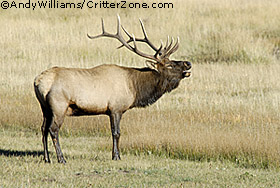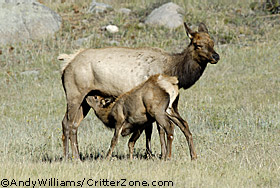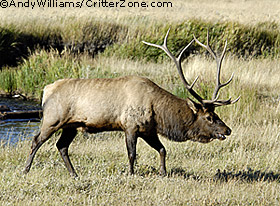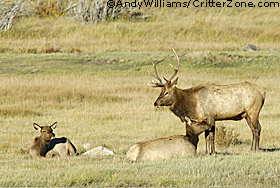|
North American Elk, Wapiti, Cervus canadensis
|
| The Elk or Wapiti is a social and polygamous mammal. Male elk are commonly known as bulls, females as cows, and fawns are called calves. Given plenty of mountain land to roam throughout the year, they will move up and down in altitude. After spending the winter at lower elevation where the snow isn't too deep, the herds move to higher elevation in the spring. The cows stop somewhat lower than the bulls in the aspen growth, where in late May and early June the calves are born. |
 bull elk, wapiti, Cervus canadensis
bull elk, wapiti, Cervus canadensis
|
| Bulls continue to the green spruce and pine forest higher up where the growth of their antlers completes. This takes place in August. In September bull elk begin to seek cows, uttering their love call or challenge, commonly called "bugling". They attempt to gather harems of cows, and often spar or fight with each other for their possession. |
| After this behavior, known as the "rut", is over and snow begins to fall, the herds gradually drift down to their winter ranges where there tends to be less snow. Here they'll remain through the winter, subsisting on grass and browsing on the brush and twigs, until the time comes around for them to return to their summer homes. |
| Bull elk shed their antlers in March or April and a new rack begins to grow right away. The new antlers attain their full size in late July or early August when the velvet covering dries up and peels off. Bulls assist this process by rubbing their antlers against trees and branches. It's not until the velvet is gone and the antlers have thoroughly hardened that the rut begins and bugling is heard. Bugling has been described as a tremendous guttural roaring that rises in pitch to trumpet tone and higher until it breaks into a shrill screaming whistle, |
 bugling bull elk, wapiti, Cervus canadensis
bugling bull elk, wapiti, Cervus canadensis
|
| then fades and drops again into the guttural, followed and ended by a few savage grunts. A furious charge and head butts with interlocking antlers may follow bull elk bugling. One bull emerges as victor and the keeper of his harem. |
| One or two calves are usually born. Sometimes there can be three. Newborns are kept hidden by the mothers for a few days, until they're able to follow them. For the first few months of their lives calves have a spotted coat which helps them stay hidden and blend into the environment. In September this coat is shed for one resembling their parents. This time of year all elk put on their winter suits. |
 cow elk nursing calf, wapiti, Cervus canadensis
cow elk nursing calf, wapiti, Cervus canadensis
|
| The name "elk" for this animal first occurs in Captain George Waymouth's book "Voyage to Virginia" first published in the year 1605. Probably a more correct name for this mammal would be "wapiti" which was first recorded by Dr. B.S. Barton in 1806. This is the name given to it by the Shawnee Native American tribe. |
Elk viewing and photography can be enjoyed in a number of U.S. national parks including Rocky Mountain National Park, Yellowstone, Grand Teton, Glacier and others.
Andy Williams / CritterZone.com |
 bull elk, wapiti, Cervus canadensis
bull elk, wapiti, Cervus canadensis
|
 bull elk with cows, harem
bull elk with cows, harem
|
The elk photos, wapiti pictures on this page are available for commercial stock photography license. All photos and text that appears on this webpage is copyrighted and may not be copied or used in any way without permission from CritterZone. You can view more photos of Rocky Mountain elk in our online gallery:
bull elk, wapiti, Rocky Mountain National Park, Cervus canadensis, stock photos
CritterZone does not specifically endorse our advertisers, or their methods. We cannot control the ads that run on our articles. CritterZone advocates humane and respectful treatment of all creatures. |
Save this page:

|